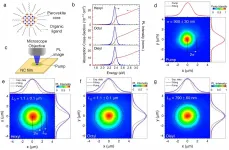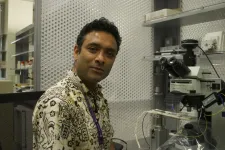(Press-News.org) Producing clean energy and reducing the power consumption of illumination and personal devices are key challenges to reduce the impact of modern civilization on the environment. As a result, the surging demand for solar cells and light-emitting devices is driving scientists to explore new semiconductor materials and improve their performances, while lowering the production costs.
Semiconductor nanocrystals (materials with sizes about 10 nanometers, which is approximately 10,000 times thinner than our hair) hold great promise for these applications: they are cheap to produce, can be easily integrated in these devices and possess exceptionally enhanced properties upon interaction with the light, as compared to their bulk counterparts. This strong coupling with light gives them a distinctive edge over conventional semiconductors, thus paving the way to high efficiency devices.
Unfortunately, this edge comes at a cost: when the size of a semiconductor is reduced, electrons can no longer travel freely across the material constrained by their physical dimensions. Furthermore, their much larger surfaces necessitate the use of passivation strategies (e.g., with organic ligands) to reduce the traps that could inadvertently affect the charge transport even further. Therefore, practical wide-spread applications of nanocrystals are limited, and their disruptive potential cannot be exploited.
In a new paper published in Light: Science & Application, a team of scientists, led by Professor Tze Chien Sum from Nanyang Technological University (NTU), Singapore, have discovered that nanocrystals made of halide perovskites possess extraordinary properties of energy transport, which replace the transport of charges, and could open new venues for implementing these materials in high efficiency devices.
Prof. Sum and his team have already pioneered the study of charge transport in these materials. In 2013 the team reported unprecedented electron transport properties for bulk halide perovskites and this discovery underpinned the successes of halide perovskites in the following years.
In this work, Prof. Sum's team demonstrated that surprisingly energy can be transported very efficiently in films made of nanocrystals. The team used a microscopy imaging system to "visualize" the energy traveling using their strong light-emission as a probe, as shown in Figure 1.
While negative and positive charges (electrons and holes, respectively) alone cannot travel inside this nanostructured material, they can team up and form so-called "excitons" to travel together, as shown in the Figure 2. The energy mobility in these materials exceeds that of other conventional nanostructures, such as Cadmium Selenide (CdSe) quantum dots by more than 1 order of magnitude. Moreover, energy can even travel in these materials further compared to what charges can do in bulk halide perovskites.
"This result is unprecedented. When you reduce the size of a material, usually it means you reduce the maximum distance that the charges can travel inside it. However, in halide perovskites, when you reduce their dimension to quantum size, these charges manage to arrange themselves into excitons and find a different way to travel. Their range now is even for longer distance than their initial travel range before you reduce their sizes!" said Dr. David Giovanni and Dr. Marcello Righetto, two of the lead authors of the work who shared equal contributions.
Here, two energy transport mechanisms were identified: the excitons "jump" very effectively between different nanocrystals, and their transport is assisted by emission light being trapped within the film and therefore reabsorbed. For the first time, scientist provided a method to distinguish these two contributions.
While the next challenge to directly implement these extraordinary properties for actual devices still remains (i.e., excitons have to be split in positive and negative charges to create a detectable current), this discovery of long-range energy transport and their mechanisms provide new ways of exploiting nanostructures into devices.
INFORMATION:
Curtin University researchers have used ancient crystals from eroded rocks found in stream sediments in Greenland to successfully test the theory that portions of Earth's ancient crust acted as 'seeds' from which later generations of crust grew.
The findings not only advance an understanding of the production of the Earth's crust through deep time, along with its structure and composition, but reveal a planet-wide crustal growth spurt three billion years ago when mantle temperatures peaked.
Lead author Professor Chris Kirkland, from Curtin University's Timescales of Mineral Systems ...
You are likely familiar with the serious consequences of anorexia for those who experience it, but you might not be aware that the disorder may not be purely psychological. A recent review from researchers at the University of Oxford in the open-access journal END ...
Highlights:
Severe cases of COVID-19 often include GI symptoms
Chronic diseases associated with severe COVID-19 are also associated with altered gut microbiota
A growing body of evidence suggests poor gut health adversely affects prognosis
If studies do empirically demonstrate a connection between the gut microbiota and COVID-19 severity, then interventions like probiotics or fecal transplants may help patients
Washington, D.C. - January 12, 2021 - People infected with COVID-19 experience a wide range of symptoms and severities, the most commonly reported including high fevers ...
PHILADELPHIA -- (Jan. 12, 2021) -- Scientists at The Wistar Institute have created an advanced humanized immune system mouse model that allows them to examine resistance to immune checkpoint blockade therapies in melanoma. It has revealed a central role for mast cells. These findings were published today in the journal Nature Communications.
Checkpoint inhibitors revolutionized therapeutic options for advanced melanoma. However, only a fraction of patients respond to this treatment and some relapse due to reemergence of therapy-resistant lesions.
"To better understand why some cancers do not respond or become resistant to checkpoint therapies, ...
Imagine you gave the exact same art pieces to two different groups of people and asked them to curate an art show. The art is radical and new. The groups never speak with one another, and they organize and plan all the installations independently. On opening night, imagine your surprise when the two art shows are nearly identical. How did these groups categorize and organize all the art the same way when they never spoke with one another?
The dominant hypothesis is that people are born with categories already in their brains, but a study from the Network Dynamics Group (NDG) at the Annenberg School for Communication has discovered a novel explanation. In an experiment in which people were asked to categorize unfamiliar shapes, individuals and small groups created ...
New research has found as climate change causes the world's oceans to warm, baby sharks are born smaller, exhausted, undernourished and into environments that are already difficult for them to survive in.
Lead author of the study Carolyn Wheeler is a PhD candidate at the ARC Centre of Excellence for Coral Reef Studies at James Cook University (Coral CoE at JCU) and the University of Massachusetts. She examined the effects of increased temperatures on the growth, development and physiological performance of epaulette sharks--an egg-laying species found only ...
COLUMBUS, Ohio - An unfortunate truth about the use of mechanical ventilation to save the lives of patients in respiratory distress is that the pressure used to inflate the lungs is likely to cause further lung damage.
In a new study, scientists identified a molecule that is produced by immune cells during mechanical ventilation to try to decrease inflammation, but isn't able to completely prevent ventilator-induced injury to the lungs.
The team is working on exploiting that natural process in pursuit of a therapy that could lower the chances for lung damage in patients on ventilators. Delivering high levels of the helpful molecule with a nanoparticle was effective ...
Abu Dhabi, United Arab Emirates, January 12, 2020: New research from NYU Abu Dhabi's Laboratory of Neural Systems and Behavior for the first time used an animal model to demonstrate how abnormal sleep architecture can be a predictor of stress vulnerability. These important findings have the potential to inform the development of sleep tests that can help identify who may be susceptible -- or resilient -- to future stress.
In the study, Abnormal Sleep Signals Vulnerability to Chronic Social Defeat Stress, which appears in the journal Frontiers in Neuroscience, NYUAD Assistant Professor of Biology Dipesh Chaudhury and Research Associate Basma Radwan describe their development of a mouse ...
ORLANDO, Fla. -- A new national survey by the Orlando Health Heart & Vascular Institute finds many Americans would delay doctor's appointments and even emergency care when COVID-19 rates are high. The survey found 67 percent of Americans are more concerned about going to medical appointments when COVID-19 rates are high in their area and nearly three in five (57 percent) are hesitant to go to the hospital even for an emergency.
In a time when every trip out of the house and every person we come in contact with poses a threat of contracting COVID-19, ...
WASHINGTON - Computer-based artificial intelligence can function more like human intelligence when programmed to use a much faster technique for learning new objects, say two neuroscientists who designed such a model that was designed to mirror human visual learning.
In the journal Frontiers in Computational Neuroscience, Maximilian Riesenhuber, PhD, professor of neuroscience, at Georgetown University Medical Center, and Joshua Rule, PhD, a postdoctoral scholar at UC Berkeley, explain how the new approach vastly improves the ability of AI software to quickly learn new visual ...




